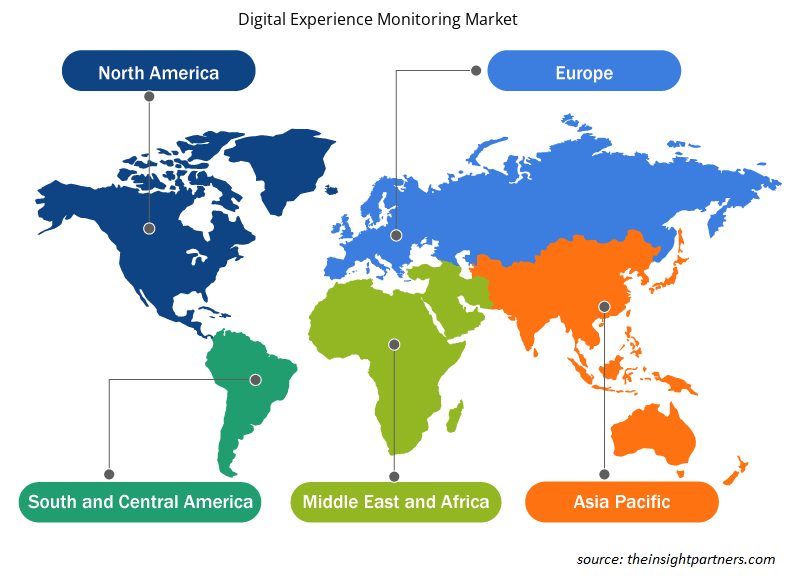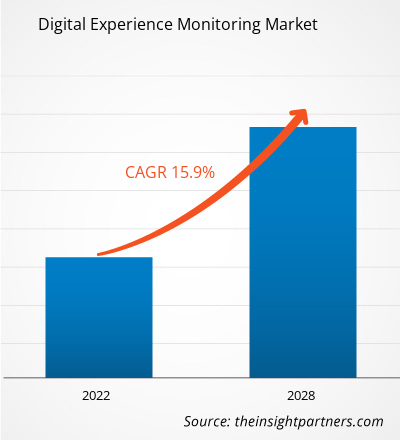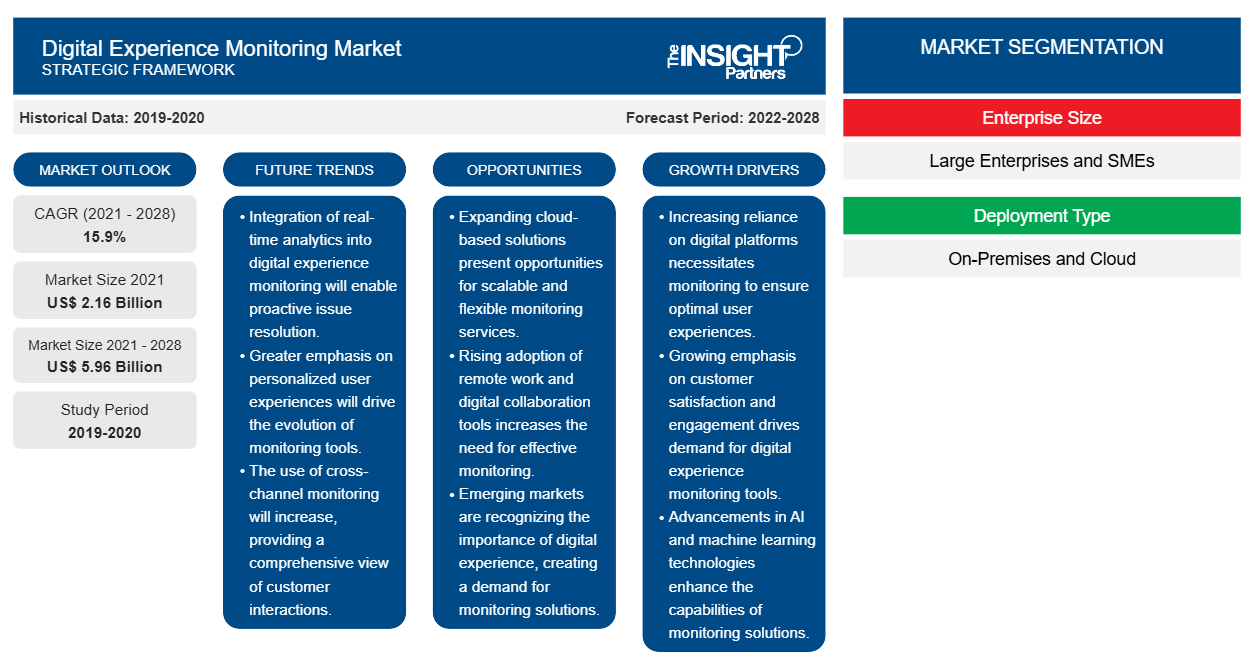Se espera que el tamaño del mercado de monitoreo de la experiencia digital crezca de US$ 2.156,71 millones en 2021 a US$ 5.960,87 millones en 2028. Se estima que el tamaño del mercado de monitoreo de la experiencia digital crecerá a una CAGR del 15,9% entre 2022 y 2028.
El monitoreo de la experiencia digital (DEM) es una nueva tecnología que las empresas están considerando como un método para simplificar las preocupaciones sobre el rendimiento del usuario y, al mismo tiempo, obtener información sobre una variedad de tecnologías de red con una única solución. La evolución del monitoreo del rendimiento de las aplicaciones (APM) y el monitoreo de la experiencia del usuario final (EUEM) hacia una solución integral que evalúa la eficacia de las aplicaciones y los servicios de una empresa es DEM. DEM es una solución de monitoreo en tiempo real que ayuda a los equipos de operaciones de TI a resolver rápidamente las preocupaciones de los usuarios y, al mismo tiempo, garantizar que la red no se vea afectada. Las tecnologías existentes de monitoreo del rendimiento de las aplicaciones (APM) y monitoreo y diagnóstico del rendimiento de la red (NPMD) se pueden complementar con soluciones DEM. Cuando se usan juntas, brindan una vista de extremo a extremo, y DEM brinda información sobre la experiencia del usuario. Esas son las experiencias que tienen el impacto más directo en los resultados de la empresa. DEM es una herramienta de monitoreo en tiempo real que ayuda a que la "máquina" de su empresa funcione sin problemas al descubrir vulnerabilidades que causan tiempo de inactividad o perturbaciones en la experiencia del usuario, como tiempos de carga de páginas deficientes, y determinar la causa subyacente del rendimiento. El software DEM monitorea el comportamiento del usuario, el tráfico y otros factores para ayudar a las empresas a comprender la usabilidad y el rendimiento del producto. Los productos DEM integran el tráfico activo o simulado y el monitoreo de usuarios reales para analizar el rendimiento teórico y la experiencia del usuario real. Estas herramientas brindan herramientas analíticas para examinar y mejorar el rendimiento de las aplicaciones y los sitios. También ayudan a las empresas a comprender cómo navegan los visitantes por su sitio y a descubrir dónde parece verse afectada la experiencia del usuario final.
El análisis de datos de rendimiento en dispositivos, aplicaciones, infraestructura y servicios para comprender cómo las interacciones de los usuarios finales con la tecnología influyen en la calidad de su experiencia digital se conoce como DEM. El departamento de TI puede rastrear y evaluar varios parámetros que afectan a los usuarios, como la CPU, la memoria, la utilización del hardware, la latencia, el rendimiento del software y más, mediante el monitoreo de la experiencia digital. Estas mediciones, que se recopilan constantemente desde el punto final y se combinan con el análisis cognitivo y la automatización, pueden ayudar al departamento de TI a diagnosticar, remediar e incluso predecir rápidamente los problemas sin el conocimiento del usuario. Los comentarios y las opiniones también pueden indicar elementos que las estadísticas de los puntos finales no pueden capturar. Las soluciones de monitoreo de la experiencia digital van más allá del monitoreo típico del rendimiento de la red y las aplicaciones para descubrir problemas de red que pueden afectar el rendimiento del servicio basado en la nube. Este factor está influyendo en el crecimiento del mercado de monitoreo de la experiencia digital .
Personalice este informe según sus necesidades
Obtendrá personalización en cualquier informe, sin cargo, incluidas partes de este informe o análisis a nivel de país, paquete de datos de Excel, así como también grandes ofertas y descuentos para empresas emergentes y universidades.
-
Obtenga las principales tendencias clave del mercado de este informe.Esta muestra GRATUITA incluirá análisis de datos, desde tendencias del mercado hasta estimaciones y pronósticos.
Impacto de la pandemia de COVID-19 en el mercado de monitoreo de la experiencia digital
Con la aparición de la pandemia de COVID-19, toda la industria de la aviación se detuvo de forma imprevista. Turquía, Irán, Sudáfrica, Irak, Israel, Arabia Saudita y los Emiratos Árabes Unidos informaron de una gran cantidad de casos confirmados y muertes por COVID-19. El mercado de monitoreo de la experiencia digital comprende las principales economías, como los Emiratos Árabes Unidos y Arabia Saudita, que son proveedores potenciales en la industria del monitoreo de la experiencia digital debido a la enorme presencia de una base de clientes diversa. Antes de la pandemia, los países del Golfo estaban a punto de adoptar tecnologías digitales transformadoras en varias verticales para mejorar las condiciones socioeconómicas de los países. Sin embargo, debido al brote de COVID-19, la implementación de medidas estrictas como cierres de fábricas, cierres comerciales y restricciones de viaje agravó los problemas económicos de los países, como el MEA. Por lo tanto, la condición económica del MEA y el impacto de la pandemia de COVID-19 en el crecimiento de varias industrias en la región influyeron ligeramente en el crecimiento del mercado de monitoreo de la experiencia digital en 2020.
Perspectivas del mercado de monitoreo de la experiencia digital
El sistema de feedback de los clientes, fundamental para cualquier industria de monitoreo de experiencias digitales funcional y rentable, se ha mejorado gracias a las mejoras tecnológicas en el mercado de monitoreo de experiencias digitales. Por ejemplo, las empresas están implementando un sistema de feedback en línea utilizando un sistema de gestión de relaciones con los clientes (CRM) de vanguardia. Como resultado, la información del cliente ayuda directamente a realizar modificaciones en tiempo real y actualizar el software de la empresa para realizar una evaluación en tiempo real de la calidad y ajustar o cambiar según sea necesario. Cualquier empresa que experimente una transición digital debe implementar sistemas de monitoreo de experiencias. La racionalización de los procedimientos digitales involucrados en el funcionamiento de una empresa establece una base sólida para futuros cambios en el sistema o la innovación continua. Esto está impulsando el mercado de monitoreo de experiencias digitales.
Perspectivas del mercado basadas en el tamaño de las empresas
Análisis del mercado de monitoreo de la experiencia digital por tamaño de empresa. El mercado está segmentado en grandes empresas y pymes. En 2021, el segmento de grandes empresas representó una mayor participación en el mercado de monitoreo de la experiencia digital.
Información sobre el mercado basada en el tipo de implementación
Análisis del mercado de monitoreo de la experiencia digital por tipo de implementación. El mercado está segmentado en local y en la nube. En 2021, el segmento de la nube representó una mayor participación en el mercado de monitoreo de la experiencia digital.
Los actores adoptan estrategias, como fusiones, adquisiciones e iniciativas de mercado, para mantener sus posiciones en el mercado. A continuación, se enumeran algunos de los desarrollos de los actores clave del mercado:
- En 2022, BMC anunció nuevas capacidades e integraciones en sus carteras BMC AMI (inteligencia automatizada de mainframe) y BMC Compuware. Las innovaciones ayudan a los clientes a mejorar la calidad del servicio y acelerar la entrega de software al brindar mayor visibilidad de datos e información basada en el contexto en todos sus entornos de TI.
- En 2021, Broadcom Inc. adquirió AppNeta para reforzar la supervisión del rendimiento de la red en Internet y en aplicaciones híbridas basadas en la nube. Al combinar la visibilidad de extremo a extremo de AppNeta con las galardonadas y probadas capacidades de infraestructura y AIOps de Broadcom, las empresas más grandes del mundo que ejecutan las redes más complejas ahora tendrán acceso a una única fuente de información para respaldar su transición a la nube.
Perspectivas regionales del mercado de monitoreo de la experiencia digital
Los analistas de Insight Partners explicaron en detalle las tendencias y los factores regionales que influyen en el mercado de monitoreo de la experiencia digital durante el período de pronóstico. Esta sección también analiza los segmentos y la geografía del mercado de monitoreo de la experiencia digital en América del Norte, Europa, Asia Pacífico, Medio Oriente y África, y América del Sur y Central.

- Obtenga datos regionales específicos para el mercado de monitoreo de la experiencia digital
Alcance del informe de mercado de monitoreo de la experiencia digital
| Atributo del informe | Detalles |
|---|---|
| Tamaño del mercado en 2021 | US$ 2,16 mil millones |
| Tamaño del mercado en 2028 | 5.960 millones de dólares estadounidenses |
| CAGR global (2021-2028) | 15,9% |
| Datos históricos | 2019-2020 |
| Período de pronóstico | 2022-2028 |
| Segmentos cubiertos |
Por tamaño de empresa
|
| Regiones y países cubiertos |
América del norte
|
| Líderes del mercado y perfiles de empresas clave |
|
Densidad de actores del mercado de monitoreo de la experiencia digital: comprensión de su impacto en la dinámica empresarial
El mercado de monitoreo de la experiencia digital está creciendo rápidamente, impulsado por la creciente demanda de los usuarios finales debido a factores como la evolución de las preferencias de los consumidores, los avances tecnológicos y una mayor conciencia de los beneficios del producto. A medida que aumenta la demanda, las empresas amplían sus ofertas, innovan para satisfacer las necesidades de los consumidores y aprovechan las tendencias emergentes, lo que impulsa aún más el crecimiento del mercado.
La densidad de actores del mercado se refiere a la distribución de las empresas o firmas que operan dentro de un mercado o industria en particular. Indica cuántos competidores (actores del mercado) están presentes en un espacio de mercado determinado en relación con su tamaño o valor total de mercado.
Las principales empresas que operan en el mercado de monitoreo de la experiencia digital son:
- Dinámica de aplicaciones LLC
- Software de BMC, Inc.
- Compañía: Broadcom Inc.
- Sistemas de punto de captura, inc.
- Dynatrace LLC
Descargo de responsabilidad : Las empresas enumeradas anteriormente no están clasificadas en ningún orden particular.

- Obtenga una descripción general de los principales actores clave del mercado de monitoreo de la experiencia digital
Perfiles de empresas en el informe de mercado de monitoreo de la experiencia digital
- Software de BMC, Inc.
- Compañía: Broadcom Inc.
- Tecnologías ControlUp LTD
- Software Lakeside, LLC
- Aternidad LLC
- Nexthink SA
- Dinámica de aplicaciones LLC
- Sistemas de punto de captura, inc.
- Dynatrace LLC
- Corporación IBM
- Microenfoque
- Corporación Oracle
- Tecnología Riverbed, Inc.
- SAP SE
- Análisis histórico (2 años), año base, pronóstico (7 años) con CAGR
- Análisis PEST y FODA
- Tamaño del mercado, valor/volumen: global, regional y nacional
- Industria y panorama competitivo
- Conjunto de datos de Excel
Informes recientes
Informes relacionados
Testimonios
Razón para comprar
- Toma de decisiones informada
- Comprensión de la dinámica del mercado
- Análisis competitivo
- Información sobre clientes
- Pronósticos del mercado
- Mitigación de riesgos
- Planificación estratégica
- Justificación de la inversión
- Identificación de mercados emergentes
- Mejora de las estrategias de marketing
- Impulso de la eficiencia operativa
- Alineación con las tendencias regulatorias























 Obtenga una muestra gratuita para - Mercado de Monitoreo de Experiencia Digital
Obtenga una muestra gratuita para - Mercado de Monitoreo de Experiencia Digital